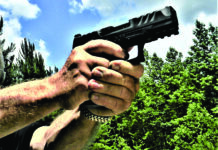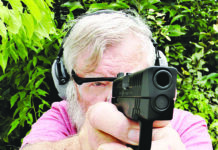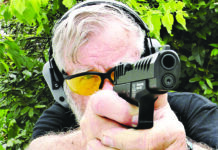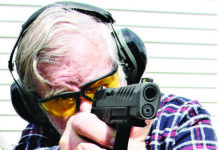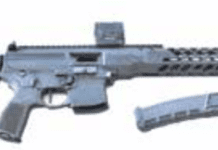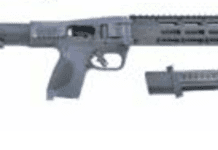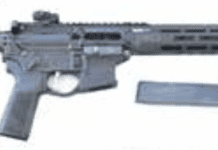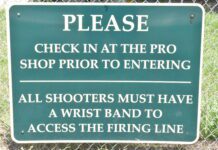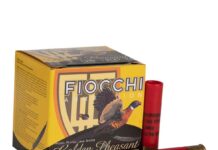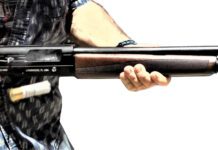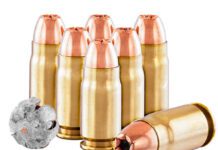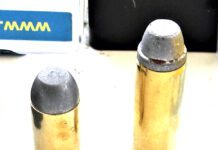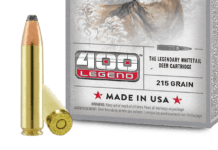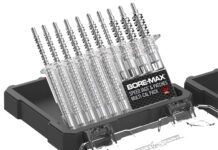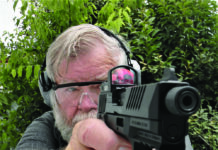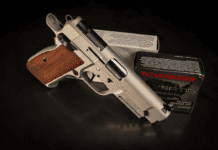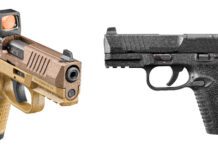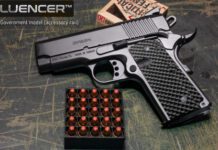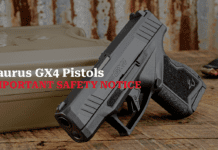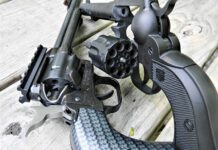Touting a Blackhawk Holster
I have owned and used quite a number of different Galco and Bianchi holsters, mostly for autos, and am quite satisfied with this one by Blackhawk. In fact, it is probably the best holster product I have seen coming from Blackhawk thus far, as I have owned others. Paid $54 at Cascade Farm & Outdoor where it was recently on sale there at 25 percent off!. I think it has pretty good retention and concealability. It's the Blackhawk No. 420506BK-R (right hand model; left hand also available). Retention is adjustable.
Gemtech Integra and Mist Suppressors: SHOT Show 2018
Gun Tests Editor Todd Woodard interviews Alexander Crown, Marketing Manager for Gemtech Suppressors, and learns about the company's suppressor-integrated uppers in 5.56 NATO and 300 Blackout and 22 LR.
Revolver Holsters: Balancing Comfort, Speed, and Retention
Revolvers remain an important part of the personal defense scene. In some shops, the majority of handguns sold for personal defense are revolvers, usually small-frame 38s and compact 357 Magnum revolvers. The 357 Magnum remains a popular handgun among a large and loyal group, such as for outdoors carry and animal defense. Still other shooters deploy big-bore revolvers in 44 Special and 45 Colt chamberings. In all these cases, the shooter has to have a good holster to carry these handguns.
The design of a holster is important, and there are features specific to the revolver. A high ride keeps the revolver cylinder off the belt line. The revolver handle must be tilted into the draw, so the cant of the holster is important. The holster must retain a balance of speed and retention. The revolver cylinder presents a problem with concealment. The cylinder bulge inhibits the design of an inside-the-waistband holster, as an example. If the cylinder bulge rides below the belt line too much, the draw is affected. One of our senior raters noted that in the early days of police transition to the self-loader handgun, many of the holsters offered were simply revolver holsters without the cylinder bulge. The difference in balance and center of gravity wasn't understood or tended to.
In this evaluation, we considered that the modern revolver holster should be an individual design. Our focus is on concealed carry, with consideration given how revolvers might be used in the field. We tested a number of holsters from major makers and found them satisfactory to excellent in fit and function.
The fit of the holster should be sufficient that the revolver may be carried during normal day-to-day movement, even a brisk walk or run, with no danger of losing the handgun from the holster. The holster should allow a good sharp draw. After the revolver is drawn, the holster must not collapse, and the user should be able to re-holster the handgun without difficulty. Here's what we found.
Alternate Bolt-Release Levers for the AR-15: We Test Three
When it comes to ambidextrous capabilities, the AR platform still lags behind the modern semi-automatic pistol. How would ambidextrous controls make the AR-15/AR-10 more desirable? One easy answer is to accommodate the left-handed shooter. Another reason would be to help keep the weapon in the fight should the operator be left with only one available hand. Ambidextrous thumb safeties are somewhat popular, and so are magazine releases, but to a lesser extent. The focus of this evaluation is to compare three different aftermarket products that offer a secondary method for releasing the bolt of the AR-15 or AR-10 rifle. They are the $30 Magpul BAD Lever, the $29 Troy Ambidextrous Bolt Release Lever, and the $80 BattleBar from Smith Tactics. Neither the Magpul or the Troy Industries units required disassembly beyond separating the upper and lower ends of the rifle. The BattleBar required replacement of the hammer and trigger pins with supplied components. All three units were made from aluminum.
Protocol for loading the AR-15 begins with pushing the magazine upward into the magazine well until it clicks then tugging on the magazine to make sure it is seated. Next, the bolt release is pressed to bring the gun into battery. Mounted on the left-hand side of the receiver directly above the magazine well, the release is the upper portion of the combination bolt-lock and release lever that pivots with a seesaw motion on a centralized roll pin. Throughout this entire process, the strong hand remains in place, supporting the rifle and maintaining access to the trigger and thumb safety.
By adding any one of our test products, the operator can save some time by moving the hand directly to the support position after seating the magazine. This may seem like a minor consideration, but experienced AR operators point to instances wherein the support hand is needed to push open a door or the shooter needs to fire immediately after completing a reload. Also, participants in High Power Service Rifle competition can use this feature when top-loading single rounds is mandatory. Placing a round into the chamber and closing the bolt with the strong hand is a lot easier than untangling a gloved support hand from a sling. For tests, all three components were mounted on multiple rifles to check fit and function. Let's see how efficiently the three bolt-release levers operated.
Gun Rights Wish List Bogs Down
We're already into the second month of the year, and 2018 is looking like 2017 regarding gun legislation. To see how far gun legislation advanced, I checked the January 2017 "Downrange" column, which had a wish list of efforts for gun owners — and saw that not much is moving, or what is moving continues at a glacial pace.
Case-Prep Stations from RCBS, Lyman, and Frankford Arsenal
If you are an avid reloader of pistol ammunition, you are probably a little spoiled. Thanks to progressive loading machines, spent pistol cases can be deprimed, resized, and belled at the case mouth one after another, just by working a single lever. Preparing rifle cases for reloading is far more tedious, with each spent case demanding not only resizing in terms of diameters but also a return to specified length by trimming the edges of the case mouth, followed by chamfering of the case mouth interior and a cleaning of the primer pocket. Each of these operations touches upon the skills of a machinist or perhaps a tool-and-die maker. As such, we decided to look at some machines that automate the case-preparation process.
When we use the word "automated," we don't really mean it in the truest sense of the word. Case "prep" stations do not enable you to pop a spent shell into one side of the machine and retrieve a fully prepared case from the other. What these machines do is offer a measure of precision and provide the elbow grease for getting the job done. To find out how much help a case-prep station can be, we shopped Brownells.com and its sister company Sinclair International (SinclairIntl.com). We walked away with a $135 Lyman Case Prep Xpress and two RCBS products, the RCBS Trim Mate Case Prep Center ($130) and the $400 Universal Case Prep Center. We also acquired a $200 Frankford Arsenal Platinum series Case Trim and Prep Center. Of the four, only the Frankford Arsenal and the RCBS Universal provided a case-trim feature.
Our test cartridge cases were Hornady 6.5 Creedmoor brass left over from recent tests that had been sized and deprimed on our MEC Marksman press (see the March 2017 issue). The fired cases measured about 1.92 inches in length or more. Our goal was to size the empty cases to as close to 1.91 inches as we could get. Consistent results were what we were after, but convenience and ease of operation would be good reasons to buy a case-prep station, too. Durability and ease of cleanup are additional considerations, but we had to ask, would the skills of a professional machinist be necessary to produce the best results? Or could anyone turn a used case into a match-ready component? Let's find out.
2017 Guns & Gear Top Picks
Toward the end of each year, I survey the work R.K. Campbell, Roger Eckstine, Austin Miller, Robert Sadowski, David Tannahill, Tracey Taylor, John Taylor, and Ralph Winingham have done in Gun Tests, with an eye toward selecting guns, accessories, and ammunition the magazine's testers have endorsed. From these evaluations I pick the best from a full year's worth of tests and distill recommendations for readers, who often use them as shopping guides. These choices are a mixture of our original tests and other information I've compiled during the year. After we roll high-rated test products into long-term testing, I keep tabs on how those guns do, and if the firearms and accessories continue performing well, then I have confidence including them in this wrap-up.
Surplus 9mm Pistols From Star and Beretta: Worth the Cash?
The idea of what constitutes a "surplus firearm" has different meanings depending where you are in the world. Surplus firearms in the U.S. means extra on hand or dated equipment. In other countries, it could mean one step away from scrap metal. We try to avoid the latter, but we are always on the lookout for a diamond in the rough, and thought we'd look at a few surplus 9mm Luger and 9mm Kurz (380 Auto) pistols. We wanted to look at these pistols through the lens of an inexpensive pistol that would be suited as a sand pit plinker, but in a pinch, it perhaps could be called on to defend the ranch. The problem with older surplus pistols is the lack or scarcity of spare parts, including magazines. By definition, all surplus weapons have been used, and some used more than others.
We chose four pistols that are fairly common and easy to find online to go bargain hunting: Two are Berettas, a Model 92S and Model 85F, made in Italy by P. Beretta S.P.A., and two are Star pistols, made in Spain by Star Bonifacio Echeverria, S.A., a Model Super B and Model B. The Star Model Super B looks like it is ready for the scrap yard and the older Model B looked well used, but as we found out, both still had some teeth. The Beretta 92S is a second-generation 92, which evolved into the 92FS. The 92S is a lot more of a European gun than the 92FS, which definitely has US influence. The Beretta 85F is a smaller version of the 92FS and is the most modern of the pistols tested.
In past issues we have tested some old-school combat pistols and found them lacking, which makes sense. A horse worked a century and a half ago; but now we (can) drive Hummers. Accordingly, we had to make some accommodations for these guns' age. Since these are older pistols, we did not test with proofing loads or +P+ loads. These pistols were not designed for that type of high-pressure ammunition, and we had no desire to taste Italian or Spanish steel. Not that we are implying these are substandard pistols. These pistols are safe when used with ammunition originally intended for them. What we did want to find out was if different bullets types would impact performance. For instance, the Star pistols were manufactured before hollow-point bullets were popular, and we figured they might choke on hollow-point ammunition. We also wanted to see if different bullet weights would cause a stovepipe jam or failure to eject. We used off-the-shelf 9mm Luger ammo consisting of Hornady American Gunner with 115-grain XTP jacketed hollow points ($47/75 rounds), Aguila 124-grain FMJs ($17/50), and SIG Sauer 115-grain FMJ ($18/50). We found all three ammo types cycled flawlessly through the pistols with no issues. In the Beretta 85F, we fired 91-grain FMJs from Tula, 90-grain Speer Gold Dot hollow points, and Hornady Critical Defense 90-grain XTPs, which feature a hollow-point bullet with a polymer insert to facilitate expansion.
For accuracy testing, we placed the pistols on a bench rest to fire at targets set at 25 yards. In speed-firing exercises, we shot at targets at 7 yards, performing both Bill Drills and Mozambique Drills. The object with the Bill Drill is to fire as fast and as accurately as possible to hit an 8-inch zone. The Mozambique requires two fast shots to center of mass and a one to the head. All must be within their zones to be successful. This is what we found out when we exercised these old pistols.
Ruger Recalls Most Mark IVs
Ruger has issued a wide recall of all Mark IV and 22/45 models because of a problem with the safety and sear and has told owners that the pistols should not be used.
The issue is: In some cases, if the trigger is pulled while the safety lever is midway between the "safe" and "fire" positions and not full engaged in either, the pistol may or may not fire when the trigger is pulled.
If the gun doesn't fire when the trigger is pulled, it may fire if the user then pushes the safety to the "fire" position without the trigger being activated.
Here's a statement from a Ruger press release on the company's website:
"Although only a small percentage of pistols appear to be affected and we are not aware of any injuries, Ruger is firmly committed to safety and would like to retrofit all potentially affected pistols with an updated safety mechanism. Until your Mark IV pistol has been retrofitted or you verify that it is not subject to the recall, we strongly recommend that you not use your pistol."
Ruger says they have received a "small number" of reports from the field indicating the problem exists. Additional testing confirmed the issue and the recall was issued.
Peruta Declined Supreme Court Hearing
I was disappointed to see that on June 26, the U.S. Supreme Court decided not to hear Peruta v. California. A Supreme Court decision would have answered some important legal questions: Does the Second Amendment's coverage for people to keep and bear arms extend outside the home? Does it cover the right to carry concealed firearms in public? Peruta might have provided definitive legal answers to those questions. Gun owners already know the answers, so we're frustrated that a natural right to self protection is hemmed in by state statutes.
American-Made 9mms: Ruger, Springfield, and Honor Defense
When it comes to 9mm carry pistols, there are several characteristics that immediately come to mind. Polymer frame, striker fired, wide grips, and high capacity. Recently we found three, or should we say three and a half pistols, that didn't quite fit that description.
The first was Ruger's $579 American Compact model 8633 that featured thumb-operated safeties on both sides.
Next were products from Honor Defense, one of the newer makers on the market. The $499 Honor Guard HG9CLE is a single-stack double-action-only pistol. The LE suffix stands for law enforcement. This gun was a variation on the original Honor Defense pistol, but it lacks a Picatinny accessory rail to favor inside-the-waistband carry for undercover work. Our 3.8-inch-long-barreled Compact LE pistol arrived with a second top end ($250, sold separately) that housed a 3.2-inch-long barrel. The shared receiver boasted unique grip contours, and both top ends utilized the same guide rod and recoil spring.
Third was the $1220 Springfield Armory 1911 EMP 4-inch Conceal Carry Contour pistol, which arrived with three 9-round magazines. The EMP operates with a single-action trigger, and this might have been our first test wherein a single-stack 1911 pistol packed more rounds than its polymer-framed competitors. Its descriptive name referred to the gun's backstrap, which has been sliced diagonally, making the rear of the grip about of an inch shorter than if it were continued in a straight line to the heel of the magazine well. This made the pistol more concealable, specifically when holstered with a butt forward (or muzzle back) cant.
Our test sessions began and ended on the reactive targets located on Steel Alley at American Shooting Centers in Houston. Accuracy data was collected from a distance of 15 yards with the guns supported by a Caldwell Matrix rest. Our choice of test ammunition consisted of Browning's new 147-grain BXP X-point jacketed hollowpoints and three different rounds from Black Hills Ammunition of Rapid City, South Dakota. They were the 115-grain JHP EXPs that were designed for maximum performance in guns not rated for +P ammunition, a 124-grain JHP +P choice, and a new subsonic round, the 125-grain non-expanding HoneyBadger ammunition. We tracked the velocity of each combination using an Oehler 35P (printing) chronograph.
All three guns were recent releases, so we really didn't know what to expect. As always our goal was to reveal reliability and accuracy as well as handling characteristics. Would we find versatility or would the accuracy of each gun be limited to a single bullet weight? Our job was to deliver to point of aim every time we pulled the trigger. Would any of these guns make that job easier than the others? Here is what we learned.
Mouse Gun Shoot Out: Three Tiny Pocket Pistols Compete
Love them or despise them, mouse guns — aka very small pocket pistols — are an important part of the self-defense landscape by virtue of their sheer numbers. For example, the North American Arms Mini Revolver is a popular handgun that has created a niche all its own. It is offered in several versions, with relatively long barrels as well as the traditional short barrel. We were interested in what type of accuracy a trained shooter could wring out of the Mini Revolver because a 6.5-ounce 22 Magnum just might have appeal as a pocket revolver or backup. We also tested a newcomer and competitor to the Mini Revolver. The PTAC Bullfrog is a copy of the NAA revolver in some ways but is mechanically different in others. We also added a small automatic pistol to the test. The Beretta 950 25 ACP handgun is a widely used pistol and can be called a standard among pocket pistols. For safety, each of the revolvers and the Beretta self-loader demand that the hammer be cocked before the pistol may be fired. Each also features a single-action trigger, although the revolvers must be cocked for each shot. In the end, we thought one gun offers a good-enough chance at stopping hostile action, but to be frank, members of our team would still be reluctant to buy it.


